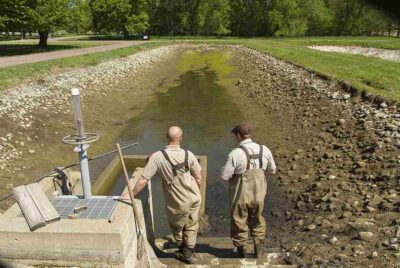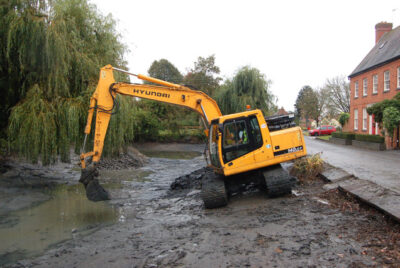How to Seal a Pond
“How to seal a pond” is the question that arises when your once charming and vibrant aquatic landscape starts suffering from water loss due to cracks or punctures in its foundation. This comprehensive guide will enlighten you on how to make your pond watertight again, assuring it continues to provide a serene sanctuary for your diverse aquatic life. Ensuring the continuity of this enchanting oasis, the guide navigates you through the process of pond repair, keeping it ever teeming with life.
What is Pond Sealing, and Why is it Crucial?
Your pond may develop leaks due to minor cracks or holes in its liner or base. These leaks might seem insignificant initially, but they can escalate into more substantial issues over time, leading to water loss and adversely affecting your pond’s ecosystem.
Pond sealing involves using specific products, known as pond sealers, to mend these cracks or holes, ensuring that your pond remains watertight. The choice of pond sealer depends on various factors, including your pond’s type, its foundation, the size of the crack or hole, and whether you plan to empty your pond for the repair.
A Primer on Different Pond Foundations
Pond foundations vary based on the material used to construct the pond. Here are the three primary types:
- Pond Liner: Typically created from PVC or rubber sheets.
- Concrete Foundation: Constructed using concrete.
- Soil/Clay Foundation: Made using compacted soil or clay.
The choice of pond sealer and the sealing method differs based on these foundations. Let’s delve deeper into each category and understand the best products and techniques for them.
Sealing Liner-based Ponds – (How to Seal a Pond)
If your pond liner has a tear or a hole, you have two alternatives. While one requires draining the pond, the other lets the water stay intact. However, remember that your pond water houses numerous beneficial microorganisms and bacteria that contribute to a diverse ecosystem. Draining the pond would mean starting afresh, so avoid it unless crucial.
Underwater Pond Liner Sealant
An underwater sealant, like the Gold Label Underwater Sealant, is a worthwhile investment for sealing your pond without needing to drain it. This solvent adapts well to liners made from rubber, EPDM, PVC, or plastic. Plus, it’s fish-friendly!
How to Apply
Applying this sealant is a straightforward process:
- Clean the affected area on the pond liner.
- Apply the sealant over the tear or hole.
- Allow it to cure for at least 24 hours.
Pond Liner Patch Kit
A pond liner patch kit is a versatile and budget-friendly solution compatible with PVC, EPDM, polyethylene, and polypropylene liners. However, using it requires draining your pond.
How to Apply
Using a patch kit is slightly more intricate but manageable:
- Drain your pond to a level a few inches below the tear.
- Clean the affected area using the wipe included in the kit.
- Scrub and dry the area using a dry scrub sponge.
- Discard the patch’s backing paper and apply it over the tear.
- Use a seam roller to apply pressure on the patch for a tight bond.
Concrete Pond Sealants – (How to Seal a Pond)
Even sturdy concrete ponds can develop cracks over time, especially in regions with extreme temperatures. However, a top-notch product like Pond Armor Pond Sealant can effectively waterproof your pond and prevent cracks from forming.
Pond Armor Pond Sealant
This epoxy pond paint sealant works wonders on concrete, cement, wood, brick, and several other materials. While it leans towards the pricier side, its high quality and reliability make it worth the investment. It’s also available in multiple colors, such as clear, black, blue, gray, tan, and white, ensuring a perfect match for your pool.
How to Apply
Applying Pond Armor is a breeze:
- Prepare and clean the surface as per the manufacturer’s instructions.
- Mix the sealer and the hardener in batches.
- Apply the sealer to the affected area.
- Allow it to cure for at least 24 hours.
- Review the application and repeat if necessary.
Soil and Clay Pond Sealants – (How to Seal a Pond)
Soil and clay ponds, common in farmlands, can be sealed using either polymer or bentonite sealers.
Polymer Pond Sealer
Polymer sealers, such as Soilfloc Pond Sealant and Damit Pond Sealer, are powders you sprinkle into the pond. Drawn to the pond’s bottom due to their positive charge, these powders expand upon reaching the cracks, effectively sealing them.
How to Apply
The application is as simple as spreading the powder evenly over the pond. However, remember these tips:
- Choose a calm, clear day for the application.
- Use a scoop or a fertilizer spreader for an even spread.
- Clear heavy vegetation from the pond to ensure the powder reaches the cracks.
- Spread the powder behind you to avoid disturbing it.
Bentonite Pond Sealers
Bentonite clay expands up to 15 times its size upon reacting with water, making it an effective but expensive pond sealer. While you can spread it over the water, it works best when applied directly to a drained pond’s foundation.
How to Apply
Here’s the popular “blanket method” for applying bentonite clay:
- Drain the pond and clear it of debris or vegetation.
- Remove around 5 inches of soil from the water bed and set it aside.
- Fill in gaps, cracks, and holes with a mixture of soil and bentonite (five parts soil to one part bentonite).
- Apply a layer of bentonite clay over the entire foundation once the holes are covered.
- Replace the soil that was removed.
- Refill your pond.
Waterfall Pond Sealers – (How to Seal a Pond)
Often overlooked, waterfall sealers are a fantastic choice if your pond includes a waterfall. TotalPond’s Waterfall Pond Sealant Foam is an excellent option for this task.
TotalPond Waterfall Pond Foam Sealant
This waterfall pond foam sealant is a polyurethane foam that bonds rocks together and fills and seals gaps. It expands two to three times its size, is fish and plant-friendly, and is the most economical option.
How to Apply
Application is straightforward:
- Shake well and attach the nozzle adapter.
- Test the foam’s adhesion by spraying a little on another surface.
- Fill in the crack, leaving about a third of the crack empty for the foam to expand.
- Allow it to cure for 12-24 hours. Repeat if needed.
Concluding Thoughts
Sealing your pond need not be a daunting task. By understanding the different types of sealers and their applications, you can select the ideal product for your pond. Whether you choose to wade through your pond while dispersing sealant or drain it to patch it up, this guide should help restore your pond to its original splendor.
Frequently Asked Questions
Q: How often should I seal my pond?
A: The frequency of sealing your pond depends on its foundation material and the quality of the sealer used. Generally, concrete and liner-based ponds require less frequent sealing than soil or clay ponds.
Q: Can I seal my pond without draining it?
A: Yes, certain products like the Gold Label Underwater Sealant and Pond Armor Pond Sealant can be applied underwater, eliminating the need to drain your pond.
Q: Is it safe to use sealants in a pond with fish and plants?
A: Most modern-day pond sealants are non-toxic and safe for both fish and plants. However, always check the product’s specifications before use.
Q: Can I use the same sealant for all types of ponds?
A: No, the type of pond sealer used depends on your pond’s foundation. Concrete, liner, and soil/clay ponds each require different sealants.
Q: How long does it take for a pond sealer to cure?
A: The curing time varies among products, but most sealants require a minimum of 24 hours to cure. Refer to the manufacturer’s instructions for precise information.




